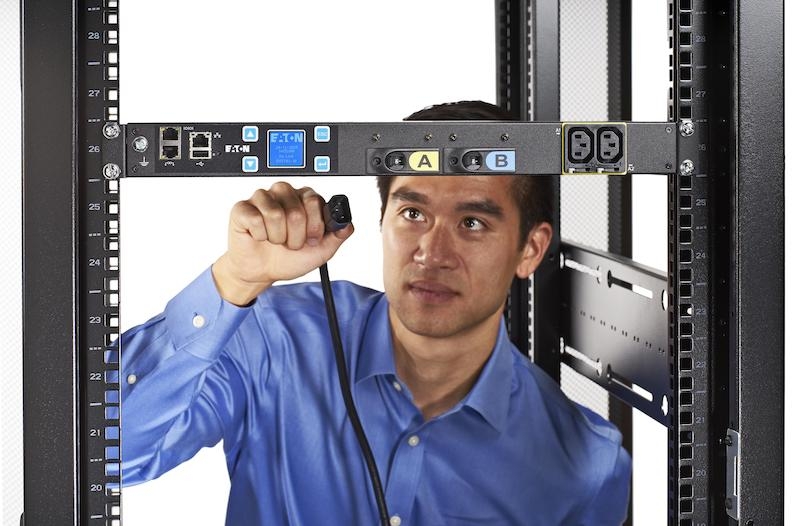
 Photo by Eaton
Photo by EatonApril 10, 2019 – Data-driven applications are the lifeline of today’s businesses, but they depend on the underpinning information technology (IT) and data centre power infrastructure to stay up and running. As the demands on such systems continue to increase, it is more important than ever for these organizations to incorporate monitoring into their power management plan, which in turn provides an opportunity to electrical contractors and other professional service providers.
Power outages can mean significant revenue losses for businesses. A recent IT Intelligence Consulting (ITIC) study found 81% of businesses across 47 vertical markets estimated their average hourly cost of downtime (exclusive of catastrophic outages) exceeded $300,000.
Power monitoring systems can enable proactive maintenance and help IT teams avoid downtime. This is especially true given recent advancements in the field.
The need for the right power infrastructure
Uninterruptible power supplies (UPSs) and power management equipment like power distribution units (PDUs) are more sophisticated and reliable now than in the past. The complex environments in which they are operated make it essential to take effective, proactive measures to help protect against issues that can arise.
In the case of a power outage, subsequent investigation and remediation can put a drain on resources. A single issue may mean staff members from multiple teams will have to spend their time troubleshooting, co-ordinating, making calls and so on, putting other, more strategic efforts on hold to address the issue.
Unscheduled events can also result in unplanned costs that are farther-reaching. For example, a facility might breach its service level agreements (SLAs) to its own clients, incurring upfront penalties and, potentially, long-term customer defections. If a service provider does not manage its power infrastructure effectively, after all, customers can move to another vendor that does.
Enhancing power monitoring
As business functions become more digitized, they are only becoming more reliant on power infrastructure. As this trend continues, IT departments are motivated to use remote power monitoring software and services to simplify processes and bring a variety of electrical devices together under one system.
With this in mind, they must weigh several factors when evaluating features and components to deploy for remote power monitoring. The following are five key concepts to consider in the deployment of a scalable system:
1. Service integration
Deploying manual, reactive power monitoring systems is not sustainable in today’s faster-paced digital world. Organizations need real-time monitoring, instead, with services provided by well-trained and experienced technicians, who can track information and follow up quickly when required.
2. Predictive analytics
With the emergence of predictive analytics, power monitoring is beginning to move from a reactive to a more proactive model. Administrators can better anticipate component failures in power equipment, days or weeks before they occur, to help avoid downtime. As development of such technology continues, diagnostic data, capture and analytics, workflows and domain expertise will continue to become more advanced, providing a scalable platform for maintenance and repair processes in the future.
3. Asset management
Organizations need to track comprehensive data about their UPSs and other power backup devices, including battery date code, model and type, firmware version, service history and capacitors. A granular level of detail should be easily accessible for inspection, reporting and remediation. This kind of information can prove extremely useful; when administrators can track data like battery date codes and service history, they can provide faster and more efficient planning and analysis.
4. Visual reporting
Power monitoring services should deliver timely, focused information to the people who need it. This can be achieved today with intuitive dashboards and devices that provide important insights into system status, as well as easy access to device-level details. Web portals and mobile apps are enabling the delivery of alerts to administrators’ mobile devices, so they can stay on top of system status no matter where they are.
5. SaaS delivery
Organizations can shift capital expenses to operating expenses and pay-as-you-go models by subscribing to software-as-a-service (SaaS). This approach eliminates the costs and efforts associated with licensing, installing and wiring on-premises monitoring infrastructures (or paying the vendor’s team to do so), in favour of self-serve installation with online support.
Optimizing continuity
A lot rides on an organization’s power system and infrastructure. Unplanned outages and other events can have a devastating impact on a business, posing the risk of missed SLAs, reduced productivity, financial penalties, brand damage and lost customers.
To optimize the continuity of their power infrastructure, IT teams will need a robust system that merges monitoring and reporting software, services and on-site technical support. There is an opportunity for electrical contractors to offer and integrate such a system for them.
Power monitoring can provide the capabilities needed to ensure uptime and dramatically improve power management. By integrating UPSs, PDUs and other electrical devices, representing multiple vendors and platforms, the system can allow for better control over an organization’s entire power infrastructure—allowing IT staff to rest easier, knowing they’re protected against any unplanned events.
Arthur R. Mulligan is a product line manager for Eaton, which develops electrical systems for power quality, distribution and control. For more information, contact him at arthurrmulligan@eaton.com.
This article originally appeared in the April 2019 issue of Electrical Business magazine.
Print this page